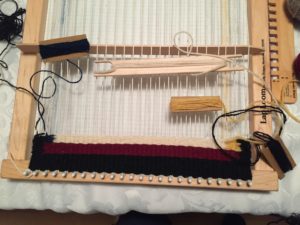Fiber Crafts, Feminism, and Subversion
Stephanie McCarter’s article “From Penelope to Pussyhats, The Ancient Origins of Feminist Craftivism: On Subversive Uses of Women’s Handicrafts Throughout History” appeared on LitHub a few months ago.
As someone who engages in a variety of typically feminine fiber arts (sewing, embroidery, and weaving), the title spoke to me. While I’ve never considered my crafting as a subversive or political act, this was an invitation to read that I couldn’t resist.
McCarter talks about how women’s handwork is decried or downplayed by many modern feminists as being unworthy or demeaning. “On the other hand, such denigration disturbingly participates in a long tradition of belittling women’s artistic pursuits, particularly those associated with poor women and women of color, which have rarely been afforded consideration as serious art.” Men’s art hangs in museums; women’s needlework is displayed in grade school cafeterias at weekend craft shows. (Each June, it’s off to Fort Bragg, California, for the annual Fort Bragg Quilt Show, which is, yes, held in a grade school cafeteria. The quilts on display are amazing works of art, meticulously planned, cut, and stitched by women with more patience in their little finger than I possess in my entire person. But, you know, they’re just quilts, so a small town grade school is the right venue for viewing, not a proper museum. /end sarcasm.)
Fiber work is a way for women to spend time doing something they enjoy, but which is perceived as virtuous (she is making something useful) or a deserved break (she is making something pretty) (as long as she doesn’t take too much time away from being useful). Realistically, it’s an opportunity for companionship, support, and bonding, and a much-needed break from daily stress. For a few years, I held a monthly “Ladies’ Circle”, to which everyone brought their needlework, artwork, and treats to share. It was the best Saturday of the month. We chatted about fun things, discussed deeply personal matters, analyzed the state of the world, and made progress on our projects which were usually rather neglected the rest of the month. It was an opportunity to indulge ourselves in positive ways (okay, there may have been rather a lot of cake sometimes!), and simply unwind while making time for the projects that didn’t get enough time otherwise. Was it resistance? Perhaps we were resisting the cultural pressure to be useful or to be helpful. But if you can’t be helpful to yourself, you can’t be useful to others.
Crafting can also be a direct subversion of power. Natalie Zarelli’s article “The Wartime Spies Who Used Knitting as an Espionage Tool” on Atlas Obscura discusses the use of knitting to encode messages in fabric to support the resistance in World War I and World War II. Whether encoding messages in their knitting, or using their knitting kits to conceal messages, the women were perceived as being useful and harmless, while recording and passing information. “Knitting used by the Belgian Resistance during World War II included dropping a stitch, which forms a hole, for one sort of passing train, and purling a stitch, which forms a bump in the fabric, for another, which helped the resistance track the logistics of their enemies. Elizabeth Bently, an American who spied for the Soviet Union during World War II and later became a US informant, used her knitting bag to sneak early plans for the B-29 bombs and information on aircraft creation.”
Even if they are not actively plotting social or government resistance, the crafting women are enjoying personal expression, creative work, and bonds of friendship. Creating strong relationships and encouraging each other’s authenticity is also a form of subversion in a society that urges conformity and fitting in. When women are still encouraged to sacrifice their personal pleasures to family or social duty, taking time to enjoy something just for yourself is subversive.
McCarter encourages us to keep at it, even if we don’t think of ourselves as political persons. “Women have honed such resistance through centuries of oppression by using its very tools. Rather than denigrate or reject these long-established feminine forms of art, we should remember them. Craft, cunning, art, coded speech—these are the weapons of the oppressed. As women’s hard-won rights grow increasingly eroded and the parameters of free speech more contested, we must always keep at hand the subversive power of craft.”
And now, if you’ll excuse me, I’m off to weave.

My Weaving Project

Leave a Reply